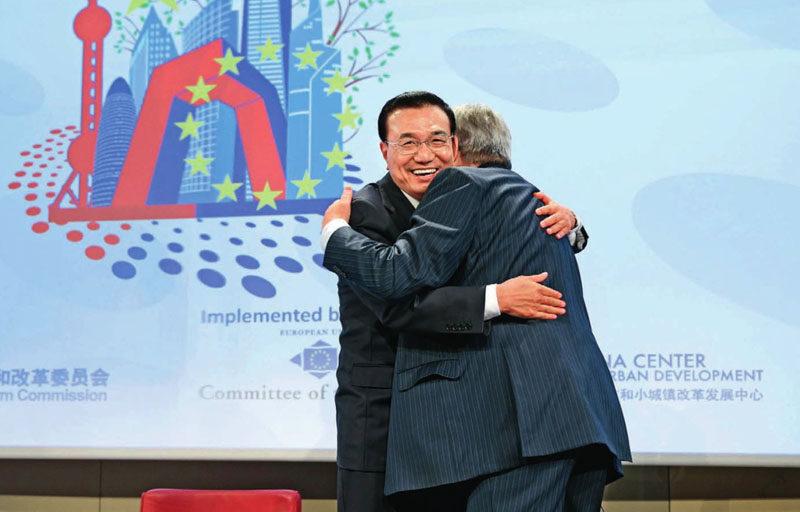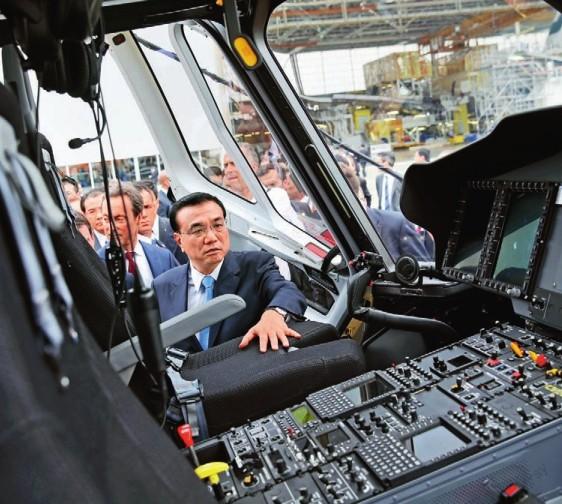Upgraded Sino-European Relations Take Shape
By TIAN DEWEN
CHINESE Premier Li Keqiang attended the 17th China-EU leaders meeting in Brussels and visited the headquarters of the Organization for Economic Cooperation and Development (OECD) in Paris during a trip to the European capitals from June 28 to July 2, 2015. The visits took place against the backdrop of a sluggish world economy lacking the energy to revive and a eurozone burdened by the debt crisis, while Chinas economy seeks a “new normal.”
The year 2015 marks the 40th anniversary of ChinaEU diplomatic ties. Over the decades, both sides have witnessed dramatic changes. China has grown into the worlds second largest economy. The European Union, which was born out of the European Economic Community consisting of 12 countries, is todays biggest supernational bloc in the world with 28 member states.
Upgrading Sino-European relations is in the interests of both sides and is meaningful to the worlds economic trends.
Raising Economic Cooperation to a Strategic Level
Economic and trade ties have always been the ballast and stabilizer in Sino-European relations. It has become a priority to upgrade the contents and forms of the bilateral cooperation as Chinas economy continues to grow rapidly while the EU is experiencing a downturn. Over the decades, China and the EU have been each others key trade partners. However, their cooperation has focused on trade in goods while mutual investment and industrial cooperation have yet to be strengthened. In recent years, the economic structures of the two parties have become less complementary, while their industrial competition has intensified, and the growth of trade volume between the two sides has slowed down. It is imperative to comprehensively renew the bilateral economic cooperation so as to give new impetus to the future development.
During his visit to Europe, Li Keqiang called for more collaboration in international production capacity between the two sides, drawing up a blueprint for the upgrading of Sino-European economic cooperation. The key areas of international industrial capacity cooperation include: integration of their respective development plans and a focus on joint infrastructure construction; exploration of third-party markets with cooperation in priority areas such as equipment manufacturing; prioritization of industrial investment and financial cooperation; and a higher level of trade and investment liberalization.
Among the four facets, connecting each others development strategies has the greatest significance seen from a long-term and overall perspective. In his Europe tour, Li pushed forward the docking of Chinas Belt and Road Initiatives with the EUs Juncker Investment Plan. The bilateral economic cooperation is expected to be lifted to a long-term development strategic level accordingly.
The Belt and Road Initiatives, proposed by Chinese President Xi Jinping in 2013, aim to adopt the historical perception of the Silk Road to build a new Silk Road Economic Belt and a 21st Century Maritime Silk Road. China will join hands with the countries along the routes to establish a community of common interests, common destiny and responsibilities characterized by political mutual trust, integrated economy, and diversified culture. In late 2014, the new European Commission President Jean-Claude Juncker announced an investment plan of315 billion, aiming to stimulate the sluggish economy by boosting reindustrialization in the member states, integrating digital markets, and transforming transport networks. The two initiatives are compatible and complementary in fields like interconnectivity, production capacity cooperation and equipment export. Building a synergy between them could give full play to the two sides production capacity and resource advantages while broadening their common interests and providing new opportunities for the development of bilateral economic and trade relations.
In order to facilitate the docking of the two sideslong-term development strategies, Li Keqiang and EU leaders held talks concerning the China-EU mutual investment funds, platforms for bilateral interconnection, and China-EU investment agreements. Both parties are currently upgrading their industrial structures. Strategies like Made in China 2025, Germanys Industrie 4.0 and the New Industrial France program have similar goals. There is much room for cooperation in this regard. Moreover, China calls for Asia-Europe interconnectivity, echoed by Europes infrastructure projects such as PanEuropean transport networks, China-Europe land-sea express line, and the new Eurasian Continental Bridge. On top of that, strategies including Chinas “Internet plus” and the EUs Digital Single Market and Smart Cities and Communities are complementary.
An all-round strategic docking in the above fields is expected to energize the bilateral trading ties. The European side has positively responded to Chinas cooperation proposals. According to President Juncker, the European Commissions vice president will soon visit Beijing to nail down a detailed roadmap for cooperation.
China-France Cooperation Sets an Example
Last year marked the 50th anniversary of the establishment of diplomatic ties between China and France.
During Premier Lis visit to France last June, the two countries issued a joint statement on deepening civil nuclear energy cooperation. Furthermore, over 70 agreements and contracts valued at nearly 70 billion were signed. The French side will also offer visa convenience for Chinese citizens. The Sino-French ties fully embody two highlights of the upgraded China-European relations.
First is to prioritize partnerships in third-party markets. China and France have come to several agreements on expanding production capacity cooperation of multiforms in fields including nuclear power and high-speed rail to explore third-party markets and achieve mutual benefit for all parties involved. On June 30, 2015, the two governments signed an agreement on cooperation in developing the third-party market. During his Europe tour, Premier Li repeatedly stressed the new concept of “joint cooperation in exploring third-party markets,” which entails combining Chinas mid-tech equipment with advanced European technologies and high-end equipment to eventually benefit all parties.
China and France are jointly developing a nuclear plant in Hinkley Point in the U.K. More infrastructure, security, finance, energy, peacekeeping and escorting, health care, and education projects are expected to be jointly carried out by the two countries in central and east Africa. The Chinese Premier pointed out that the consensus on cooperation with third parties reached by China and France will encourage more developed countries to take part in this field. Sino-French relations, which take the lead in the ties between China and Western countries, have gone one step further.
Second, personnel exchanges will be more convenient. People-to-people exchange is a constant driving force for the progress of China-Europe relations. On July 1, Premier Li Keqiang and his French counterpart Manuel Valls announced that France will issue more multi-entry visas valid for up to five years to Chinese citizens. China has allowed France to set up several visa offices outside the French embassy and consulates in China to make visa applications more convenient for Chinese citizens. In addition, Manuel Valls expressed hopes of welcoming 50,000 Chinese students to France in the near future, a substantial increase on the 30,000 today. An internship program involving 1,000 young people from the two countries will be launched as well. According to Li, all measures are aimed at making it easier for people to work, study, and travel between the two nations. Whats more, China and the EU have agreed to set up visa centers in 15 Chinese cities that do not have embassies or consulates for EU member nations in order to meet the surging demand of Chinese citizens heading for Europe.
A Responsible Major Country
Chinas role as a responsible major country lays a solid foundation for upgrading Sino-European relations. Li Keqiangs visits to Europe have showcased Chinas image as an open, tolerant, and responsible major country, which enhances the worlds expectations of and confidence in China.
First of all, China is concerned with the development of Europe. The Greece debt situation deteriorated in June. The Chinese premier, when attending the 17th China-EU leaders meeting, reiterated Chinas support for European integration and the expectation of a prosperous Europe, a united European Union, and a strong euro currency. He noted that China had contributed to helping Greece overcome its crisis and fulfilled some of Greeces requests by practical actions. China, a bosom friend of the EU, is willing to play a constructive role in solving the European debt crisis and hopes to see the revival of Europe as a whole.
Secondly, China is playing an active role in dealing with climate change. During a meeting with French President Fran?ois Hollande, Li Keqiang announced that China had formulated a document on its nationally determined actions on cutting emissions and submitted it to the Secretariat of the UN Framework Convention on Climate Change. In the document, China vows to bring its CO2 emissions to a peak by around 2030, and make efforts to peak early; lower CO2 emissions per unit of GDP by 60 to 65 percent from the 2005 level; increase the share of non-fossil fuels in primary energy consumption to around 20 percent; and raise the forest growing stock by 4.5 billion cubic meters from the 2005 level. The country will also continue to actively adapt to climate change and improve its abilities in such areas as risk resistance, forecasting and early warning, and disaster prevention and damage reduction. President Hollande highly appreciated the Chinese governments position, which showed firm supports for the upcoming Climate Change Conference in Paris and a significant opportunity for the international community to tackle climate change and promote sustainable economic development.
Last but not least, China endeavors to build new relationships with developed countries. Li Keqiang attended a ceremony marking Chinas official entry to the OECD Development Center in Paris. He is the first Chinese leader to visit this organization. In his speech at the OECD, the Premier stated that China remains the biggest developing country in the world. But it is possible for the nation to build a new relationship with developed countries in which cooperation on international production capacity and with third parties are important parts. To date, employment in China is relatively steady while income keeps increasing and the environment continues to improve. China is capable of reaching its seven percent annual growth target. The countrys economic growth and the endeavor it has made to set up a win-win international relation new order are favorable elements for world peace and progress.

